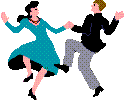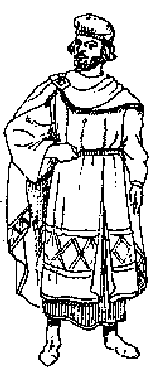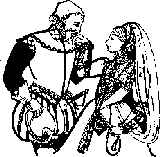History of Dance
 It is not known when people began to dance; however, because expressive movement is so spontaneous, because dance is almost universal, and because it is so intimately interrelated with other aspects of a culture, it is possible that dance developed along with the evolution of our species. Many animals perform dancelike movements in situations similar to human courtship and play. These movement rituals, however, lack the conscious use of symbols that is present in human dance.
It is not known when people began to dance; however, because expressive movement is so spontaneous, because dance is almost universal, and because it is so intimately interrelated with other aspects of a culture, it is possible that dance developed along with the evolution of our species. Many animals perform dancelike movements in situations similar to human courtship and play. These movement rituals, however, lack the conscious use of symbols that is present in human dance.
Prehistoric cave paintings from more than 20,000 years ago depict figures in animal costumes who seem to be dancing, possibly in hunting or fertility rituals, or perhaps merely for education or entertainment. Because all cultural groups are continually changing, no societies survive today who are like Paleolithic or Stone Age peoples or who dance as they may have danced. A few cultures that exist today, however, have had little or no direct contact with industrialized societies. At times their dances may look simple to an outsider, but often they are not. Usually they form part of complicated rituals that involve highly sophisticated religious or philosophical ideas. Furthermore, because most of the dances are for participation, they must be easy to learn. Such societies may also possess presentational dances. Among Australian aboriginals and African Khoi-san peoples, for example, skilled individuals perform mime and acrobatic dances to entertain and instruct.
Ancient Civilizations  Written as well as visual evidence of dance has survived from the ancient civilizations of the Mediterranean region and the Middle East. Egyptian tombs depict people who seem to be dancers, often in acrobatic positions such as backbends; these figures probably represent professional entertainers who were slaves. Dancing was essential to agricultural and religious festivals such as the dance-rituals enacting the cyclic death and rebirth of the god Osiris (symbolizing the seasonal cycle of the Nile).
Written as well as visual evidence of dance has survived from the ancient civilizations of the Mediterranean region and the Middle East. Egyptian tombs depict people who seem to be dancers, often in acrobatic positions such as backbends; these figures probably represent professional entertainers who were slaves. Dancing was essential to agricultural and religious festivals such as the dance-rituals enacting the cyclic death and rebirth of the god Osiris (symbolizing the seasonal cycle of the Nile). The Greeks admired dancing, including it among the activities fostered by their art, religion, and philosophy. Greek warrior or pyrrhic dances were part of military training. Religious dances, especially those honoring Dionysus, the god of wine, are believed to be the origin of the dance in Greek drama. In tragedy, the chorus used symbolic gestures and dance steps to accompany the spoken or sung verse.
The Greeks admired dancing, including it among the activities fostered by their art, religion, and philosophy. Greek warrior or pyrrhic dances were part of military training. Religious dances, especially those honoring Dionysus, the god of wine, are believed to be the origin of the dance in Greek drama. In tragedy, the chorus used symbolic gestures and dance steps to accompany the spoken or sung verse. The ancient Romans are known especially for their development of pantomime. Although professional Roman dancers, pantomimists, jugglers, and acrobats worked as traveling entertainers, dance degenerated under the Romans, some of whom saw it as immoral.
The ancient Romans are known especially for their development of pantomime. Although professional Roman dancers, pantomimists, jugglers, and acrobats worked as traveling entertainers, dance degenerated under the Romans, some of whom saw it as immoral.
 Medieval Europe
Medieval Europe
The Christian church, which dominated the European Middle Ages, disapproved of dancing. Dancing continued among the people, however, both in communal festivals and as entertainment. Variations of medieval peasant dances continue today as folk dances. Some peasant dances, taken over and adapted by the aristocracy, became courtly social dances that in turn evolved into ballet.


